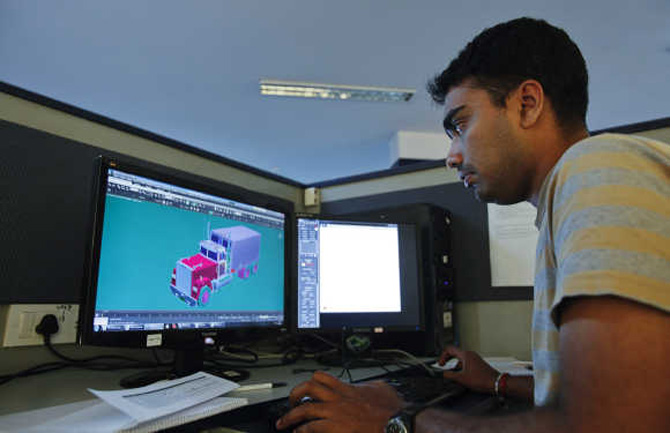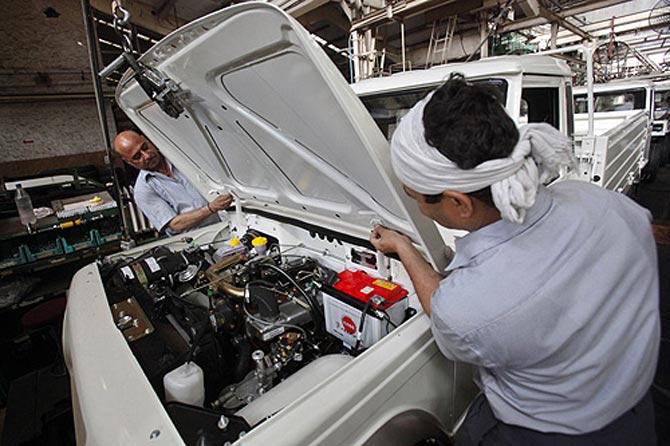
Resumption of rapid GDP expansion requires accelerated growth of the production and export of manufactures, says Ajit K Ghose.
The period 2000-2010 was a golden period, one of rapid services-led economic growth in India; the economy grew at an average annual rate of 7.2 per cent, and around 63 per cent of this growth came from growth of services.
This experience gave rise to a number of hubristic beliefs: that India has inherent strengths in services; that the rapid services-led growth resulted from India’s success in exporting skill-intensive services; and that manufacturing-led growth at early stages of development is an obsolete idea.
These beliefs have served to create a perception that rapid services-led growth will continue, that India has arrived, having leapfrogged over a phase of manufacturing-led growth.
Though growth has since dwindled, the perception survives. It is widely believed that the growth slowdown currently being experienced is temporary and that rapid services-led growth will return soon.
Yet a factual scrutiny shows the beliefs to be little more than wishful thinking. The services-led growth, by generating high-wage non-manual jobs for the educated, has been of immense benefit to the middle classes.
...

The end of this pattern of growth naturally appears as a dreadful prospect to them. This at bottom is the reason why the beliefs survive. Their survival, however, will bring much harm; for, it will prompt India’s policy makers to keep knocking on locked doors.
India’s services-led growth does not reflect certain inherent strengths of Indians; it has been the result of past policies. Ironically, it was the Mahalanobis strategy of industrialisation that built some of the pre-conditions for services-led growth.
The core of that strategy — the promotion of heavy industries producing capital (e.g., machines) and intermediate (e.g., steel) goods — called for strategic priority to be accorded to tertiary education, cheap capital and the public sector.
So, many resources went into building of institutions of tertiary education and to subsidisation of students in these institutions, even while primary and secondary education remained neglected. Capital too was subsidised in a variety of ways (cheap credit, low import duties, overvalued exchange rate).
...

These policies made both skilled labour and capital relatively cheap. On the other hand, labour regulations, introduced with the good intention of ensuring a decent livelihood for workers in the modern part of the economy, had the effect of making unskilled/low-skilled labour relatively expensive.
This is how the organised segment of India’s economy came to acquire comparative advantage in the production of capital- and skill-intensive goods and services.
Alongside, there were other policies that favoured services and disadvantaged manufacturing. Services have been much more lightly taxed than manufacturing. Inadequate attention to physical infrastructure (roads, railways, ports, airports) has constrained manufacturing far more than services.
Trade and foreign investment regimes have been made more favourable for services than for manufacturing. These policies and policy biases explain India's premature services-led growth.
...

It is simply not true that this growth was triggered and sustained by the growth of services exports. Services-led growth actually began in the early 1980s (when exports were insignificant) and not in the late 1990s (when exports were significant and growing).
To be sure, the growth of services exports contributed to accelerated growth of services during 2000-2010. But even in this period, growth of exports was far less significant a contributor to services growth than growth of domestic demand; a simple growth accounting exercise shows that growth of services exports accounted for only 13 per cent of services growth while growth of domestic demand accounted for 78 per cent (growth of services inputs into agriculture and industry accounting for the rest).
The share of services exports (in value added terms) in services output has never been large; even at its peak in 2009, it was only 12 per cent and the average for the period was 8 per cent.
Growth of software exports, it is true, has been very impressive, but software output has been and remains a minuscule part of services output. The rapid growth of services was supported by rapid growth of domestic demand.
Given India’s low per capita income, the fact of rapid growth of services being supported by rapid growth of domestic demand appears rather puzzling. But some plausible explanations are available.
...

Technological change and product innovations in transport and communication seem to have increased the share of expenditure on these services for all income groups. And rapid skill-intensive growth seems to have fed on itself; it enabled public expenditure and hence public services to grow and it caused a shift in private expenditure in favour of services by increasing income inequality.
Has India really leapfrogged over a phase of manufacturing-led growth? One cannot help wondering why India should have this unique privilege. Historically, the developed countries of today went through a long period of manufacturing-led growth before entering a phase of services-led growth.
The emerging economies of today, other than India, have all experienced manufacturing-led growth.
Rapid services-led growth over a fairly long period in a low-income economy such as India is indeed without precedent. But it does not mean that India has leapfrogged over a phase of manufacturing-led growth.
In fact, services-led growth has already reached a dead-end and the growth slowdown reflects this. The balance of payments difficulties that India faces today are a consequence of the services-led growth of yesterday.
...

That pattern of growth resulted in a growing anomaly between domestic absorption — the consumption and investment of citizens and government — and domestic production (GDP).
Rough calculations show that the share of goods in domestic absorption was 75 per cent in 2000 and 67 per cent in 2010. On the other hand, the share of goods in domestic production was 51 per cent and 43 per cent in those two years respectively.
High and growing net imports of goods were thus needed to meet the requirements of domestic absorption.
Net exports of services have never been, and can never be, adequate to finance more than a small fraction of the required imports of goods. In 2010, for example, net exports of services could conceivably have financed at most 30 per cent of the net merchandise imports.
...

The currently high level of current account deficit, which reached 4.3 per cent of GDP in 2012 and still remains around that level, reflects the anomaly between domestic absorption and domestic production generated by a long period of services-led growth.
This level of current account deficit is not sustainable and that is fundamentally why services-led growth is not sustainable either.
Resumption of high growth now requires accelerated growth of production and export of goods, particularly of manufactures. India has not leapfrogged over a phase of manufacturing-led growth; it stands at the beginning of such a phase.
The sooner India’s policy makers recognise this, the better. For, serious reorientation of a whole range of policies — public investment, foreign trade, subsidisation of capital and skilled labour, and labour regulations — is required to boost development of physical infrastructure, to facilitate exports of manufactures and to increase relative prices of capital and skilled labour vis-à-vis unskilled/low-skilled labour.
(The author is, currently, Honorary Professor at the Institute for Human Development, New Delhi, and, formerly, Senior Economist at the International Labour Office, Geneva.)